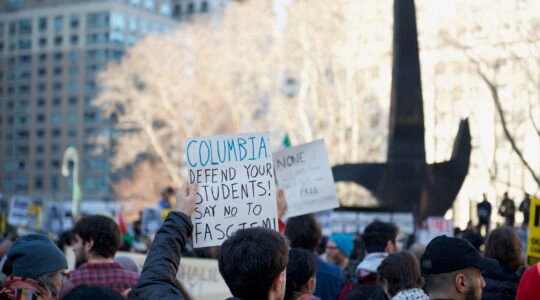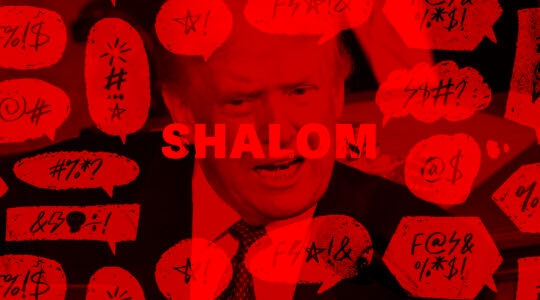We are in the season of the High Holy Days, when many Jews will be spending significant time in the synagogue. As an architect, I have had a number of opportunities to design synagogues, forcing me to think about the spatial and phenomenological aspects of communal prayer. [Jewish Week staff writer Steve Lipman addressed some of these issues in a Sept. 11 article, “The Shape Of Worship To Come.”]
The synagogue’s primary function is what happens in its sanctuary, the space in which the congregation prays together. But there is a basic contradiction between sincere, personal prayer and the communal, synagogue setting. In prayer, we strive to connect to our most personal feelings of longing, hope, regret and gratitude. For some, this is a transcendent conversation with a divine God, while others may use prayer as a tool for personal introspection and reflection.
But communal prayer seems to suggest a different experience, one of choreographed ritual, a shared text and the camaraderie of a sing-a-long. Could one have a meaningful prayer experience in a public setting? How could I access those fragile moments of spiritual intimacy within the synagogue environment?
This tension can be traced back 1,500 years to a famous Talmudic disagreement [Brachot, 26b] as to the origin of prayer: “R’ Yossi the son of R’ Hanina said: ‘Prayers were established by the forefathers.’ R’ Yehoshua Ben Levi said: ‘Prayers were established in place of the daily sacrifices.’”
These opinions offer different understandings of the nature of prayer. R’ Yossi suggests that prayer is derived from the forefathers’ spontaneous, intimate communication with a personal God; R’ Yehoshua sees prayer as a continuation of the public daily rituals of temple sacrifices.
These two attitudes can be seen within our High Holy Day prayers. While the services are performed within the synagogue — a communal setting reflecting R’ Yehoshua’s sensibility — the selected Torah and Haftorah readings reflect R’ Yossi’s opinion by retelling the biblical stories of spontaneous prayer: Hagar and Ishmael for water, Chana for a child, and Jonah for rescue from the ocean.
In order to understand the experience of communal prayer we need to first consider the experience of praying. Prayer is a framework in which we strive to access our authentic feelings through a liturgy that expresses the full range of human emotion and experience. Our prayers express our amazement at the sunrise, our despair over national destruction, our pained cry for health and our gratitude for the lives we have.
But the wish to experience authenticity — kavanah — in prayer is not an easy one. So often we struggle, not only in prayer but also in our daily life, to know what we are feeling. Mentalization is a term psychologists use to describe the capacity to understand our own emotions and to correctly interpret the feelings of those around us. As children, we learn this from trusted caregivers who mirror our feelings. “I see that you are angry,” I might say to my daughter who is having a tantrum. By giving her overwhelming feelings a name, I help her understand her emotions and calm down. We continue developing our mentalizing abilities in adulthood, as we navigate complex and confusing work and family interactions.
Prayer, whether seen as introspection or as a transcendent conversation with a divine God, allows us to access emotions that have been hidden behind the profanity and banality of everyday life. Where else can I voice my fears of death, aspirations for my children and regret for my mistakes? If prayer is understood as a framework for emotional honesty, then community supports this process of personal discovery.
The Hebrew term for a house of prayer, Beit Knesset, literally means house of assembly, a meaning also preserved in the English term “synagogue” derived from the Greek term for assembly. As the name suggests, the synagogue’s essence is not its physical form or location, but rather the assembly of the minyan — the quorum of 10 — which creates a communal space for the full prayer service. The traditional prayer book is written in the plural, emphasizing the congregation’s symphony of voices that is richer than any individual voice could be.
But community can also overshadow the individual with an oppressive collective atmosphere, similar to a political rally. Prayer must therefore occupy a delicate position that offers a supportive, mutual experience, while also protecting the individual’s sense of agency; it must accept ambivalence alongside faith.
Perhaps this is the meaning of the Talmudic passage [Brachot, 7b], which says: “And I shall pray to you God, at a time of favor. When is it a time of favor? When the community prays.” It is by praying with community, while maintaining the dignity of the individual, that we create a unique time of favor allowing us to experience the pain and joy, despair and yearning, of being human before God. n
Esther Sperber is an architect and the founder of the Manhattan-based Studio ST Architects. She also writes on architecture and psychoanalysis.
The New York Jewish Week brings you the stories behind the headlines, keeping you connected to Jewish life in New York. Help sustain the reporting you trust by donating today.





